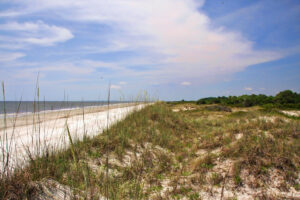
Sapelo Island is one of Georgia’s barrier islands. At 16,500 acres, Sapelo is the fourth largest. Like most of Georgia’s other barrier islands, Sapelo Island was formed by sediments from the Pleistocene epoch Silver Bluff shoreline, and the current Holocene shoreline. The island is a tidally-influenced barrier island, and experiences semidiurnal tidal cycles (two high and two low tides per day). Sapelo has many tidal creeks and marshes, which drain and refill with the tides. High tide pushes water into the marshes, and at low tide, when the ocean has receded, water drains from the marshes into the creeks. Changes in the tides can easily affect the island’s geomorphology. Hurricanes don’t often affect the Georgia coast, but storm surge from Hurricane Irma in 2017 created a new island between Blackbeard and Sapelo, called Little Blackbeard Island.
Other Sapelo island ecological environments, aside from the tidal creeks and salt marshes, include beaches and sand dunes. Most of the beaches, including Cabretta and Nannygoat beach, are formed from Holocene sediments. These sediments originate from the continental shelf and are transported and deposited on Sapelo by the tides. The island’s upland areas are forested. The most common forest types are pine and maritime, which includes mixed oaks and hardwoods.
Humans have lived on Sapelo Island for thousands of years. Archeologists have found evidence of Native American presence during Archaic times, including the Native American Shell Ring, a ceremonial mound. In the nineteenth century, Sapelo island was used for plantation agriculture. In the 1850s, 385 enslaved workers lived on the island. Ever since there has been an African-American community presence on the island, even following the civil war and the end of Sapelo’s plantation economy.
In modern times, Sapelo island is managed by the state of Georgia, and is uninhabited with the exception of the Hog Hammock community. Visitors must be part of an organized tour or have a permit. Hog Hammock is a continuing landscape as the last known Gullah community. However, the Hog Hammock community is shrinking, and has less than a hundred residents. Some residents have willingly left the island, and others are at risk of being forced off. Since the 1990s, some mainlanders have been buying land from Gullah residents and building vacation homes, resulting in property tax increases that threaten the livelihood of some remaining Gullah residents.
Post written by Penelope Helm.
Sources/Further Reading:
Berson, S. (2018, January 29). Hurricane Irma created a whole new island off the Georgia Coast. Ledger-Inquirer. https://www.ledger-enquirer.com/news/state/georgia/article197172749.html
Georgia Coast Atlas. Sapelo Island. http://georgiacoastatlas.org/sapelo-island.html
Marine Institute on Sapelo Island. Island Habitats. University of Georgia. https://ugami.uga.edu/sapelo-island/island-habitats/
Sullivan, B. (2002, June 17). Sapelo Island. New Georgia Encyclopedia. https://www.georgiaencyclopedia.org/articles/geography-environment/sapelo-island/
Sapelo Island. (2021, November 25). In Wikipedia. https://en.wikipedia.org/wiki/Sapelo_Island